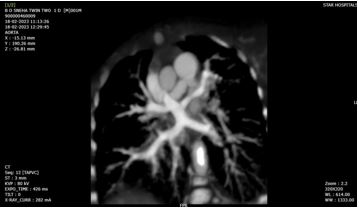AN UNUSUAL PRESENTATION OF TOTAL ANOMALOUS PULMONARY VENOUS RETURN IN DICHORIONIC DIAMNIOTIC TWINS
DOES IT HAVE A GENETIC BACKGROUND?
Abstract
Congenital heart defects (CHDs) represent the most common human birth defect, having a birth prevalence of 7-9 per 1000 singleton births . CHDs are more common in twin pregnancies with a prevalence of approximately 20 in 1000 live births.Monochorionic (MC) twins are at even higher risk compared to Dichorionic (DC) twins.Herein, we report a scenario where Dichorionic Diamniotic (DCDA) twins who presented with the same type of CHD (TAPVR: Total anomalous pulmonary venous return) in our Neonatal intensive care unit(NICU).Several familial cases of TAPVR have been reported, but no notable pedigree has been reported.Multiple case reports have shown a genetic background of TAPVR.Screening of all siblings with TAPVR is a burden to the patients due to psychological stress or financial problems on the parents. However, these consequences are outweighed by the benefit of diagnosing this critical disease early so that the patient can be taken for surgery before severe congestive heart failure develops. Therefore, if a genetic background is detected in a case of TAPVR, routine fetal echocardiography or cardiography immediately after birth is reasonable to screen TAPVR.
Downloads
References
2. Best K.E, Rankin J. Increased risk of congenital heart disease in twins in the North of England between 1998 and 2010. Heart 2015, 101, 1807-1812.
3. Brown DW, Geva T.Anomalies of the pulmonary veins.In Allen HD, Driscoll DJ, Shaddy RE, Feltes TF, editors. Moss and Adams heart disease in infants, children, and adolescents: including the fetus and young adult.8th ed. Philadelphia: Wolters Kluwer Health/Lippincot Williams and Wikkins;2013.p822-33.
4. Bleyl s,Ruttenberg HD, Carey JC, Ward K. Familial total anomalous pulmonary venous return: a Large Utah-Idaho family.Am J Med Genet 1994:52:462-6.
5. Warkany J.Etiology and morphogenesis of congenital heart disease.Am J Dis Child 1981;135:389-90.
6. Bleyl S, Nelson L, Odelberg SJ, Ruttenberg HD, Otterud B, Lepert M, Ward K.A gene for familial total anomalous pulmonary venous return maps to chromosome 4p13-q12.Am J Hun Genet 1995;56:408-15.
7. Ramer JC, Mowrey PN, Robins DB, Ligato S, Towfighi J, Ladda RL. Five children with del (2)(q31q33) from a single family: review of brain, cardiac, and limb malformations. Am J Med Genet 1990;37:392-400.
8. Wu CH, Hwu WL, Wang JK, Young C, Peng SS, Kuo MF. Deletion of 11q24.2-qter with agenesis of unilateral carotid artery and total anomalous pulmonary venous return. Am J Med Genet 2001:103:245-8.
9. Degenhardt K, Singh MK, Aghajanian H, Massera D, Wang Q, Li J, Li L, Choi C, Yzaguirre AD, Francey LJ, Gallant E, Krantz ID, Gruber PJ, Epstein JA.Semaphorin 3d signaling defects are associated with anomalous pulmonary venous connections. Nat Med 2013;19:760-5.

Copyright (c) 2023 Author (s). Published by Siddharth Health Research and Social Welfare Society

This work is licensed under a Creative Commons Attribution 4.0 International License.


 OAI - Open Archives Initiative
OAI - Open Archives Initiative


